Douglas DC-3/C-47 Dakota
Background
The DC-3 and its family is so well known that it is not necessary to go into its design history here. The type was introduced into New Zealand by the USN R4D which first arrived in September 1942. (An Australian bound DC-3 had been shipped by sea, passing through Wellington in October 1938). They were then issued to the RNZAF under the lend/lease system arranged in September 1942, for their use in the Pacific. The first NZ3501, a C-47 (c/n 9111 ex 42-32885) being taken on strength at Whenuapai on March 27 1943, and flown by S/Ldr Fred 'Popeye' Lucas. A total of 49 C47/C47A/C47B aircraft (NZ3501-3506, 3516-3558) were operated by the RNZAF in the 1943-1977 period. The aircraft were operated in a transport role by No's 40, 41 and 42 SQN along with No1 OTU. The aircraft were used for passenger and cargo work, VIP transport, paratrooper operations, and as target tugs. Six were lost in service. Thirteen more were reduced to spares or scrapped. Of the remainder, one was tranferred to the Ministry of Transport Calibration flight, one was sold to James Aviation, and all but two transferred to NAC. Of these, four were later returned
The last six RNZAF C-47's were struck off charge in 1977. One aircraft (NZ3551) a VIP transport is preserved with the RNZAF museum in the condition it was used during the Royal tour of 1953. The remainder were the subject of political controversy. After their sale it was thought they had been purchased with the intention of operating them in Rhodesia, then subject to an embargo. After sitting at Harewood (Christchurch) they were actually flown via Singapore and the Comoro Islands to South Africa in the early 1980's. The five were all on strength with the South African air force by 1985, and served until 1997-8. In the interim they were re-engined with turbo-props. After being struck off charge by the SAAF, one entered the South African register, and the remainder have been acquired by Dodson International in the USA. (Further info is in the survivors section below -thanks to Charlie H. and Peter L. for helping me sort through the changes in identity).
Many of the former RNZAF aircraft that went on to operate with the New Zealand National Airways Corporation (NAC) continued the work they had done in the war years. 40 Squadron had begun quasi-civil operations carrying fare paying civilians in January 1945. Post-war the government moved to set up an airline, which became NAC which took over this role. Operations began in September 1946, and the airline officially came into existence on June 1, 1947 using converted DC-3s, Lodestars, and several smaller types. A total of 28 DC-3 aircraft were operated, of which 26 were ex RNZAF C-47s. The other two were purchased in Australia, being a C-47A ZK-BKD (c/n 13521 described below) and a DC-3-277D freighter ZK-BKE (c/n 4119, ex 41-7697, VH- CAD, VH-ANI) originally ordered for American Airlines. During 1963-64 fifteen of the fleet were converted to 'Skyliners', which involved fitting larger windows and upgrading the interior. The type was officially phased out by 1970, with ZK-BBJ making the last scheduled run on August 20. However, ZK-AOF (c/n 16151/32899) temporarily returned to service from Christchurch when Timaru and Oamaru airports were resealed. The last flight was on December 20. NAC lost three aircraft in service; ZK-AOE (c/n 16383/33131) on August 9, 1948 at Rununder Point with two killed; ZK-AQT (c/n 15948/32696) on May 22, 1954 at Raumati with three killed; and ZK-AYZ (c/n 15204/26649) on July 3, 1963 in the Kaimai ranges with 23 killed. Four aircraft were returned to the RNZAF, six were sold for conversion to agricultural aircraft, and the remainder were sold overseas.
Two other scheduled airlines operated DC-3 aircraft. South Pacific Airlines of New Zealand (SPANZ) operated from December 1960 to February 1966, providing services on a range of routes nationwide. Formed by ex-NAC Captains Rex Daniell and Bob Anderson, the airline operated three of its own aircraft; ZK-BYD 'Ernest Rutherford' (c/n 13906); ZK-BYE 'Jean Batten' (c/n13529); and ZK-CAW 'George Bolt' (c/n 18293), all 'viewmaster' aircraft converted by major shareholder Ansett Transport Industries and imported from Australia. In addition the airline leased several aircraft including G-AMKE (c/n 14483/25928) and several NAC aircraft. Despite introducing a number of innovations to the previously spartan operating environment (viewmaster windows, in flight catering, etc) as well as opening routes to previously unsupported centres, the economic, political, and regulatory environment put harsh constraints on an airline. The receivers were eventually called in, and the airline made its last commercial flight on February 28, 1966. BYD and BYE were eventually sold overseas (going to Laos) while CAW is described below. The other airline was Mt Cook and Southern Lakes Tourist Company, which had been founded in 1928. Having started Ski-plane operations in 1956, the company recognised the need to bring tourists into its areas of operation. The acquired their first DC-3 ZK-BKD (c/n 13521) from NAC on October 25, 1961. They purchased two more, ZK-AOD (c/n 15701/27146) on October 31, 1964 and ZK-BEU (c/n 13099) on June 25, 1970. An extra aircraft was also chartered from NAC from time to time. The company began to re-equip with the HS748 in 1968 and the DC-3s were slowly retired, BKD in July 1970 (described below), AOD in November 1972 (to Field air who reduced the aircraft to spares, registration withdrawn April 13, 1976), and BEU in 1975 ( the aircraft was later broken up as part of a film production).
A role almost unique to New Zealand was the Ag-Dak. The use of DC-3's for top dressing was pioneered by James Aviation. Ossie James saw the increased efficiency in using a larger aircraft when most topdressing was being carried out with Tiger Moths and Austers. He convinced the government to part with an RNZAF aircraft in May 1954 (c/n 16568/33316 NZ3545 ZK-AZL), and after civil conversion by de Havilland at Rongotai, the aircraft was modified for its new role in Hamilton. The first load was dropped on December 1, 1955, and the concept was so successful that other companies chartered the aircraft. James Aviation also pioneered the conversion to allow single pilot operations in 1959, with changes to the undercarriage and flap controls, and the addition of hopper controls. At a 29000lb MTOW, the aircraft carried a 5 ton load. Fixed static loaders were eventually fitted at the aerodromes frequented by the ag-daks, some of which were in remote areas. (James Aviation are reported to have provided vehicles (Fiat 500 Bambina/ BMC Mini) loaded through the cargo door for operators away from home). Thirteen aircraft were eventually used in this manner. In 1960 James Aviation, Rural Aviation, and Fieldair formed 'Airland', who took over use of AZL. Airland purchased a number of DC-3 aircraft for conversion. ZK-BYF (c/n 20051) went into service on Mar 4, 1961, followed by ZK-CHV (c/n 17093/34360) on Sep 21 1964, ZK-APB (c/n 15945/32693) on December 8 1965, ZK-CQA (c/n 14585/26030) on August 13, 1966, ZK-AWO (c/n 33480/16732) on October 15 1968, and ZK-APK (c/n 34227/16967) on October 13, 1970. James Aviation had reclaimed AZL in 1963, and purchased a further aircraft , ZK-AOI (c/n 34226/16966) in December 1966 which worked for a short period in early 1967. This aircraft was stored in Hamilton till June 1970, when it worked from Ardmore and Rukuhia, and then in early 1971 went into service for James Aviation's subsidiary Southern Super Air. Fieldair began acquiring there own ag-daks, when ZK-BKD (c/n 13521) went into service on Aug 28 1971, and ZK-CAW (c/n 18293) on Nov 22 1972. James Aviation put two more aircraft into service. ZK-AZA (c/n 27144/15699) entered service on March 5 1973, and ZK-AWP (c/n 33135/16387) on July 27. The latter was a replacement for AOI which had crashed near Clarence on February 23, 1973 after the starboard wing seperated from the aircraft. The last ag-dak to enter service was ZK-BBJ (c/n 16962/34222) which had been purchaed by Fieldair in October 1971, but was not converted until December 1974. By this stage, the early ag-daks were being phased out of service. Age and economic changes were catching up with the aircraft. AZL was retired in September 1974, CQA (July 8, 1975), CHV (March 29, 1979), AZA (October 10, 1979), BYF (June 20, 1981), APK (July 3, 1981), APB (November 16, 1981), BKD (23January, 1983), AWO (March 1, 1984), CAW (October 29, 1984) and AWP (May 27, 1985). Fieldair absorbed the Airland operation in 1978, so from 1979 they were the sole ag-dak operator. The last of the ag-daks was ZK-BBJ, which Bruce Thompson worked from Gisborne until May 1987, when it was flown to Palmerston North to be converted to a freighter. (The fates of these aircraft are described in the survivors section below).
The last DC-3 'fleet' operation was set up in 1986. AS SAFE Air's Cook Strait freight operation was being wound up, Peter Vincent and a partner imported ZK-AMR (c/n 11970) formerly operated by the RAAF, and a number of Australian Airlines, on July 7, 1986. This was prepared along with Feildair's former ag-dak ZK-AWP for freight operations from Wellington which commenced in September 1986. The aircraft operated to Blenheim, Nelson and Christchurch under the 'Fieldair Freight' banner (Feildair Holdings being the 60% partner). ZK-BBJ joined the operation after being retired from ag-work in 1987. Air Freight (NZ) was set up as a stand alone company to run the operation in mid-1989. Contracts included NZ Post and Speedlink (a NZ POst division). Some of the aircraft carried the 'Speedlink' titles. The freight operation ceased at the end of March 1993. The three aircraft were put up for tender. ZK-AMR and ZK-BBJ were sold to Morris Catering for support work with the UN in Cambodia and subsequently Somalia and Kenya. The aircraft departed in April and May 1993 (see below). AWP was sold locally.
Other DC-3 aircraft were inbound to New Zealand in the same period. ZK-AMS (c/n 9286) a former RAAF C-47A operated by a number of Australian airlines was imported by Pionair Adventures. Arriving as VH-PWN on May 3 1992, the aircraft was registered on July 15 1993, and overhauled by Fieldair at Palmerston North before starting tourist operations fromQueenstown. ZK-AMY (c/n 13506), another Australian C-47A was imported by Peter Vincent as VH-CAN on April 8, 1994 and entered the New Zealand register on Auguste 24. He set up Vincent Aviation to run a similar operation in Wellington. They ceased their DC-3 passenger and freight operations in mid-1998 (see below). AWP was involved in another short lived charter operation (also called Classic Air) - see below for further details. This leaves Pionair's tourist operations as the last commercial operation of a DC-3 n Christchurch and Auckland (where they are associatedwith ZK-DAK). ZK-DAK (c/n 15035/26480) is another Australian C-47B imported in 1990 by a Warbirds Association syndicate and based at Ardmore.
As at April 1, 2001 the airworthy DC-3s are:
- ZK-AMS (c/n 9286 ex 42-23424 A65-9 VH-EAM, VH-EWR, VH-EWF, VH-PWN) C-47A Was a 1943 built aircraft supplied to the RAAF, who used it as a transport in the Pacific. Sold to QANTAS in 1947, the aircraft remained in their service for six years. The aircraft was subsequently flown by a number of operators (at least five) around Australia and in New Guinea. It had accumulated over 54,000 hours prior to going to its last Australian owners in Adelaide in 1985. Sold to Pionair Adventures, the aircraft was registered on July 15 1993, and overhauled by Fieldair at Palmerston North before starting tourist operations, initially at Queenstown. Known as 'Dulcie', AMS is now based in Christchurch with Pionair. (illustrated below)
- ZK-AMY (c/n 13506 ex 42-93579 VH-ASD, VH-CAN) C-47A Was imported by Vincent Aviation in 1994. Built as a C-47A 42-93579 for the USAAF, after its military service the aircraft was sold to Australia where it became VH-ASD with the Dept of Civil Aviation. The registration was changed to VH-CAN in August 1950. Between 1978 and 1992 the aircraft passed through five owners. Registered as ZK-AMY in August 1994, the aircraft operated from Wellington with Vincent Aviation. In mid-1998 the aircraft was put in storage with Fieldair at Palmerston North. In October 1998 the aircraft was registered to GYM Properties, Nelson. In 2001 it was great to see the aircraft returned to work, this time with Pionair. (illustrated below)
- ZK-AWP (c/n 33135/16387 ex 44-76803 NZ3543, 5W-FAI) Is the only ex-RNZAF Dakota still airworthy in New Zealand. Built in 1944 as a C-47B , the aircraft served as NZ3543, being brought on charge on May 13 1945, and struck off on July 3 1952. During this time the aircraft was issued to 41 Squadron, including time based in Singapore. As noted above, it served with NAC from July 1952, and was one of the last 2 DC-3s retired from their fleet. Initially operated as 'Powhaitere', after conversion to Skyliner staus in May 1963, the aircraft was named 'Kaitaia'. Between February 2, 1970 and June 8, 1973 the aircraft was operated by Polynesian Airlines as 5W-FAI. Sold to Southern Air Super Ltd on August 3, 1973, ZK-AWP was converted as a top-dresser. Passed to Fieldair on July 14 1975, the aircraft was used as a top-dresser until May 11, 1985, and then converted back to freight work. It operated from Wellington with AMR and BBJ under the FieldAir Freight and Speedlink titles. Sold to the Alpine Fighter Collection in August 1993, it then spent time with Classic Air at Paraparaumu before passing to Mackley Aviation at Ardmore in December 1995. Ownership passed to NZ Aerial Mapping at Napier in 1998, and the aircraft has subsequently been returned to NAC plumage. Recent activity has been charter work (passenger and film). Latest reports indicate this aircraft is up for sale. (illustrated below)
- ZK-DAK (c/n 15035/26480 ex 43-49219 PI-C486 VH-PNM VH-SBT) C-47B The aircraft was built in 1943 (c/n 26480) and was operated by the USAAF as 43-49219. The aircraft has accumulated over 43,000 hours with the military and as an airliner in the Philippines (PI-C486), New Guinea (VH-PNM), and Australia (VH-SBT). The DC-3 was acquired from Mackay Air Museum in Queensland by a Warbirds Syndicate, and registered on April 4, 1990. The aircraft now wears the colours of the 48 Squadron aircraft flown by Rex Daniell (SPANZ co-founder) in the attack on the Orne bridges. The large yellow WB and D-day stripes being useful in the interests of visibility. The aircraft is based at Ardmore and operated by Pionair. (illustrated below)
DC-3's on display include:
- NZ3551 (c/n 16963/34223 ex 45-960) C-47B Taken on charge by the RNZAF from August 14, 1945 and first flown on August 21, the aircraft was operated until January 24, 1978 initially as a freighter, and from 1953 in the VIP role. Converted for the Coronation tour, the interior was split into two cabins with seating for eight. Given it's special history, the aircraft was reserved for the most important VIPs, and this lead to its choice for preservation to represent the RNZAF DC-3 fleet. The aircraft made its final flight from Ohakea on January 25, 1978, and is on display at the RNZAF Museum.
- 17221 (c/n 13319 ex 42-93410) A former USN LC-47H, operated by VXE-6 (the 'Puckered' Penguins) as part of the Deep Freeze operations between New Zealand and Antarctica between 1956 and 1967. Donated to commemorate the link between the countries, the aircraft is now at Ferrymead in Christchurch (illustrated below).
- ZK-AZL (c/n 16568/33316 ex 44-76984 NZ3545) C-47B was delivered to the USAAF on April 23, 1945. Taken on charge by the RNZAF at Rukuhia on June 17, 1945, and struck off on August 7, 1957. In the interim it served with 40 and 41 Squadron, including time in Malaya. Initially withdrawn from service in August 1952, the aircraft was to go to NAC, but was recalled as a backup for the 1953 Royal Tour. Purchased by James Aviation (14 May 1954), It was sent to de Havilland at Rongotai for civil conversion on June 24. The aircraft was the first DC-3 in New Zealand converted for agricultural work, arriving in Hamilton on August 11 for the equipment to be fitted. Test flights were made on December 11, 1955. Named 'Hi Land Duster' the aircraft made its first commercial flights near Kawhia on December 3, 1955. The operation of the big topdresser was successful, and the aircraft was chartered by other companies. In 1959 the aircraft was converted for single pilot operation - another first. In 1960 when 'Airland' was formed, AZL was loaned as James Aviation's contribution. The aircraft returned to James Aviation in 1963. In later years, the aircraft is reported to have worked 600-800 hours a year, operating at altitudes of 120-200' AGL, and spreading up to 100 tons of fertiliser in a day. When retired in 1974, the aircraft had added 9959 hours to the 4081 it completed in RNZAF service. The registration was not cancelled until June 6, 1984. The retired aircraft was donated for display at the National Fieldays site at Mystery Creek, Hamilton where it remains today.
- ZK-BQK (c/n 16576/33315 ex 44-76983, NZ3844) C-47B was taken on charge by the RNZAF on June 14, 1945 and struck off on July 17, 1952. The aircraft was damaged in a landing accident having run into a windsock while making a single engine landing. The aircraft was sold 'as is' to NAC who stripped it of parts and put what was left in storage. The aircraft was registered on May 10, 1956 and converted for passenger services. It entered service on October 16 1957, and operated as 'Koreke'. Converted to Skyliner standard in June 1963, the aircraft was renamed 'New Plymouth'. Withdrawn by NAC in December 1969, the aircraft was leased to Polynesian Airlines. After retirement, the 50,345 hour veteran aircraft was donated to MoTaT on July 23, 1973. The aircraft is displayed in its former NAC colours.
- ZK-BYF (c/n 20051 ex 43-15585 N65393) Built in 1943 and delivered on April 12, 1944, this aircraft served with the US military before being sold to Trans Pacific Airlines in 1953, then Aloha Airlines in November 1958. Brought to New Zealand on December 4 1960 and registered on February 23 1961 to Rural Aviation, the aircraft was converted for ag-work in Hong Kong (to James Aviation plans) and brought back to New Zealand on March 4 1961. They passed it to Airland on August 25 1966 , it was later passed to Fieldair at Palmerston North on February 20 1978. Named 'Kotuku' the aircraft worked as a top-dresser until it was withdrawn from use on January 20, 1981, when it was retired with a total of 34,891 hours. Purchased in 1982 by John Regan, the aircraft was transported by road to Lower Hutt where work on restoring the aircraft to wartime configuration was started by the Silverstream Aeronautical Society. In 1992 the aircraft was transported again by road to Ohakea where further restoration work was completed. The aircraft was painted as NZ3547 (actually sold to South Africa) and displayed on loan outside the Museum as a 42 SQN aircraft as seen during the 1960s and 70s. In 1998 this aircraft was removed from display as it had been put up for sale. Purchased by the Gisborne Aviation Preservation Society (GAPS), it was moved by road to its new home during May 20-22, 2000. The aircraft is currently on display at Gisborne airfield at the GAPS facility. (illustrated below)
A number of DC-3s remain substantially complete, having become restaurants/ bars - including:
- ZK-APK (c/n 34227/16967 ex 45-964 NZ3556 ZK-AOK NZ3556 VQ-FAH) C-47B Delivered to the USAAF on July 24, 1945. Taken on charge by the RNZAF at Rukuhia on August 21, 1945. Served with 40 and 41 Squadrons. Registered to the Air Secretary as ZK-AOK on February 19 1947 and returned to the RNZAF on April 11. Re-registered to the Air Secretary as ZK-APK on May 6, 1947. Sold to NAC on May 31, 1947. Registered on June 20, 1947 and operated initially as 'Poaka'. Converted to skyliner status in August 1964 and operated as 'Kaikohe'. Leased to Fiji Airways from May 22, 1967 to October 2, 1967 as VQ-FAH. Sold to Airland on June 11, 1969 (their last DC-3 purchase) and entered service as a topdresser on October 13, 1970. Passed to Fieldair on February 20, 1978. Retired on July 3, 1981 and stored at Palmerston North. The aircraft had completed 42,764 hours (695 RNZAF, 6,193 topdressing). Registration was cancelled on March 30, 1984. Purchased by Rangitikei River Adventures in at Mangaweka in 1985 and renovated before being moved to Mangaweka in 1986. The aircraft was lifted onto a pedestal on November 1, 1986 where it has subsequently been used as a tearooms. In early 2000 the aircraft was removed from its pedestal for refurbishment (the control surfaces in particular had become rather tatty) and repainting before being lifted back. The new scheme (replacing the former black and yellow of Fieldair) is a rather spectactular advertisment for a biscuit company. The aircraft continues in its food industry role. (illustrated below)
- ZK-BKD (c/n 13521 ex 42-93592 VH-ANU) C-47A The aircraft was delivered to the USAAF on June 6, 1944. After its war service, it was purchased by Australian National Airways On Dec 17, 1945. The aircraft came to New Zealand after being purchased by NAC and was registered on June 27, 1955, and operated as 'Kotare'. Sold to the Mt Cook and Southern Lakes Tourist Company on October 25, 1961, it was the first of three DC-3s owned by the company. When the DC-3's were phased out in favour of HS748, BKD went back to NAC (July 3, 1970), but was sold onto Fieldair (July 13, 1970). The aircraft entered service on August 28, 1971 as the first DC-3 to wear Fieldair titles. After being retired on January 23, 1983 the aircraft was stored at Palmerston North. Acquired for a local museum, the aircraft was later moved to Rotorua for a proposed museum there, and stored on land opposite the airport. The museum did not come to pass (Hamish Ross, the owner having been killed in a topdressing accident), and the aircraft was subsequently transported to Gisborne where it now serves as a wine bar.
- ZK-CAW (c/n 18293 ex 41-100460 VH-ANM ZK-CAW VQ-FAI) C-47A Delivered to the USAAF on Oct 15, 1943, the aircraft was later sent to Australia and for a time loaned to the RAAF. Became VH-ANM with Australian National Airways on February 6 1947. Passed through three other Australian Airlines (Queensland Airlines, February, 4 1956; Ansett-ANA, December 7, 1958 who converted it to viewmaster standard; and Airlines of New South Wales, February 14, 1961) before being sold to SPANZ in September 1961. It was registered as ZK-CAW on October 13,1961. Imported to New Zealand, the aircraft was operated by SPANZ as 'George Bolt'. After the collapse of SPANZ, the aircraft passed to NAC on February 28, 1966. The aircraft was subsequently leased to Fiji airways until Aug 5, 1969, after which it was leased to Mt Cook Airlines. When surplus to requirements, the aircraft was stored in Christchurch, after which it passed to South Seas Airways sometime before it was registered on May 7, 1971. As the charter company could not get an operating license, and the aircraft required overhaul, it almost immediately (May 13) went to Fieldair. After conversion, it began ag-work on November 22, 1972 named 'Whio', and went on to complete 6,286 hours in the role. The aircraft was withdrawn from service on October 29, 1984 having completed 56,282 hours. Sold to Richmond Harding of Wanganui Aero Work on May 28, 1985, the aircraft was towed to Wanganui where it was proposed to restore the aircraft to airworthiness in passenger configuration. Prohibitive costs meant the plan was abandoned, and in 1989 the aircraft was towed to Taupo where the aircraft was refurbished, fitted with viewmaster style windows and painted. The registration was cancelled on July 10, 1990. The aircraft was then displayed in Taupo as a feature of the Aeroplane Car Company's caryard. On November 6, 1990 the aircraft again went into service, this time as an extension of the MacDonalds restaurant next door. (illustrated below)
Sundry partial survivors include:
- NZ3503 (c/n 9420 ex 42-23558) C-47A The aircraft served with the RNZAF from May 24, 1945 to May 20, 1948, after which the aircraft was reduced to spares and scrapped at Woodbourne. This aircraft was noted for it's nose art - a stork with baby featuring the legend 'Anything, Anywhere, Anytime'. Only the nose survives, in storage with the RNZAF Museum.
- ZK-APB (c/n 32693/15945 ex 44-76361 NZ3534) C-47B Delivered to the USAAF on February 15 1945, and subsequently to the RNZAF at Rukuhia on March 7, 1945. The aircraft served with 40 and 41 Squadrons, acting as the first air ambulance while with the later. Struck off charge by the RNZAF on March 22, 1947 having being sold to NAC. The aircraft went on the New Zealand register on April 28 1947, before going to ANA for civil conversion. It made its first commercial flight on October 30, 1947 and operated as 'Popotea'. Its operations included the Pacific regional routes, and this aircraft made the first scheduled evening flight between Paraparaumu and Whenuapai on 1 November 1949. APB was withdrawn from NAC service on August 31, 1965, and was subsequently sold to Airland as their third Ag-Dak. NAC carried out the conversion and the aircraft started work on December 8, 1965, although the registration change does not appear until Jan 5, 1966. Ownership passed to Fieldair on on February 20, 1978. APB was withdrawn from use on November 16, 1981. The aircraft had completed 41,588 hours, including 7,904 as a topdresser. Stored at Palmerston North until sold in 1983, the aircraft was transported for use in a Petone amusement park on November 30, 1983. The retired aircraft subsequently passed through several locations, before major components were included as a feature of the Aerodrome Tavern in Miramar. The nose section was last reported in a yard in central Wellington.
- ZK-AWO (c/n 33480/16732 ex 44-77148 NZ3548) C-47B Delivered to the USAAF on June 15 1945, then to the RNZAF at Rukuhia on July 7. Served with 40 Squadron, before being issued to 41 Squadron on Mar 25 1946. Loaned to NAC on July 1, 1952 and registered on Jul 11. The aircraft operated as 'Putaitai' until September 5, 1966, initially with passengers and from 1958 as a freighter. Delivered after conversion for ag-work to Airland on March 21, 1967 as their fourth DC-3. Registered on April 12, but did not commence work until October 15 1968. Passed to Fieldair on February 20, 1978. Withdrawn from use on March 1, 1984 having completed 32,846 hours (8,737 hours as a topdresser). The registration was cancelled on May 29, 1985. Stored in Palmerston North, the aircraft was sold to the Awapuni Motor Hotel with the intention of display. The aircraft was subsequently moved to Awiti and after a dispute with the local council, it was scrapped. The cockpit section was rescued and moved to a Feilding farm around 1994. The damaged section was purchased by Chris Rudge in 2000 and transported to Christchurch, where the gutted cockpit has been cleaned up and work has begun on restoring the cockpit fittings.
- ZK-AXS (c/n 32743 ex KN372) An RAF Dakota IV, it was reputedly used by Lord Mountbatten during his time as the Supreme Commander of the SEA Command late in WWII. The aircraft was purchased for the Ministry of Transport Calibration flight and registered on October 20, 1950. The Calibration flight tested a variety of navigation and flying aids in New Zealand and around the Pacific islands. AXS was written off after an undercarriage failure at Paraparaumu on November 6, 1970 when repair was deemed uneconomic. The fuselage was passed to the fire service for training. A fuselage section is reported to still be in use for training at Wellington.
- ZK-CHV (c/n34360/17093 ex 45-1090 N87672) C-47B Delivered to the USAAF on Oct 5 1945. Later modified as an SC-47. Registered to Aero American Corp of Arizona in 1961, who sold the aircraft to Airland in June 1964. The aircraft was flown to Christchurch for ag-conversion by NAC and entered service on September 21, 1964 at Napier. It was entered on the New Zealand register on September 22, 1964. The aircraft passed to Fieldair on February 20, 1978. Withdrawn from use on March 29, 1979, having completed 18,395 hours (8,962 hours as a topdresser). The aircraft was reduced to spares by Fieldair at Palmerston North. The derelict fuselage is reported to still be there for use by the rescue service.
- ZK-CQA (c/n 26030 ex 43-48769 N87655) C-47B Delivered to the USAAF in September 1944. Later modified as an SC-47. Registered to Aero American Corp of Arizona in 1961, who sold the aircraft to James Aviation in March 1966. The aircraft was flown to Christchurch for ag-conversion by NAC. Registered on March 25, 1966, it entered service as James Aviation's second Ag-Dak on August 13, 1966, based at Ardmore. In June 1970 the aircraft was prepared for a COA overhaul at Rukuhia and found to be in a poor state. It was subsequently sold to Fieldair on an 'as is' basis on August 25, 1970. The aircraft was withdrawn from use on July 8, 1975, and the registration cancelled on March 11, 1977. The aircraft was reduced to spares by Fieldair at Palmerston North. The fuselage was given to the Rescue Fire service at Palmerston North. The remains of the fuselage are reported to be at Ohakea.
New Zealand related (particularly ex-RNZAF) aircraft I know of which are no longer in New Zealand are:
- 12418 A USN R4D-5, operated by VXE-6 (the 'Puckered' Penguins) as part of the Deep Freeze operations between New Zealand and Antarctica between 1956 and 1967. The aircraft were fitted with weather radar, extra fuel tanks, skis, and jato bottles for these operations. Named 'Que Sera Sera' , this aircraft landed at the South Pole on October 31, 1956. The aircrat was shipped back to the USA in December 1959. Today it is preserved at the USN air museum at Pensacola, Fl.
- 9J-RDR (c/n 14483/25928 43-8667, KJ888 G-AMKE, VP-YUU) C-47B supplied to the RAF in 1944, it served predominantly in South East Asia. Put on the UK civil register in 1951, the aircraft was operated by BEA until 1961 when it was sold to Air Links. The New Zealand connection came between December 1961 and March 1962 when the aircraft was leased to SPANZ and operated on their New Zealand routes. Later in 1962, after returning to the UK, the aircraft was sold to Rhodesian Air Services and registered VP-YUU. After passing to Air Rhodesia in 1965, the aircraft was sold the following year to Zambia Airways, taking its final registration. The aircraft is believed to have been withdrawn from use by the end of 1970. Its subsequent history is vague, and it appears to have been broken up in Lusaka in 1989. Some of the remains have found their way to display in a pub near Rand airport in South Africa.
- N146RD (c/n 16149/32897 ex 44-76565 NZ3538 ZK-AOG NZ3538 ZK-AQP D6-CAF SAAF 6858) C-47B Taken on charge by the RNZAF on April 8, 1945 and struck off on September 29, 1947. Registered to NAC on October 14, 1947 and after conversion to civil status operated as a freighter, named'Peho' . The aircraft was withdrawn from use on September 4 1966 and transferred back to the RNZAF on October 15th. The aircraft was retired on November 12, 1977 after participating in a final flypast as Ohakea. The aircraft was then flown to storage at Palmerston North, and later Harewood. Put up for tender, the aircraft was sold in November 1978, the registration being changed on December 20. Suspicion that the aircraft was bound for Rhodesia kept the aircraft in New Zealand till December 1980. By mid-1981 the aircraft was actually in South Africa with the SAAF. Later the aircraft was re-eingined as a turbo-prop. The aircraft was retired sometime in 1997, and subsequently sold to US company Dodson International. Last reported (2000) to be airworthy in the United States.
- N81907 (c/n 16565/33313 ex 44-76981 NZ3546 ZK-AWQ D6-CAG SAAF 6863) C-47B Taken on charge by the RNZAF on June 20, 1945 and struck off on July 2, 1952. Registered to NAC on July 15, 1952 and after conversion to civil status operated as 'Patarai'. The aircraft was transferred back to the RNZAF on April 17, 1961, being removed from the civil register the following day. The aircraft was retired on November 12, 1977 after participating in a final flypast as Ohakea. The aircraft was then flown to storage at Palmerston North, and later Harewood. Put up for tender, the aircraft was sold in November 1978, the registration being changed on December 20. Suspicion that the aircraft was bound for Rhodesia kept the aircraft in New Zealand till December 1980. By mid-1981 the aircraft was actually in South Africa with the SAAF. Later the aircraft was re-engined as a turbo-prop. The aircraft was retired sometime in 1997, and subsequently sold to US company Dodson International. Last reported (2001) to be at Wonderboom in South Africa undergoing refurbishment to airworthiness with P&W R-1830 powerplants.
- N8190X (c/n 16730/33478 ex 44-77146 NZ3547 ZK-AZM D6-CAD SAAF 6865) C-47B Taken on charge by the RNZAF on July 7, 1945 and struck off on March 27, 1953. Registered to NAC on April 1, 1953 and after conversion to civil status operated as 'Karoro'. Moved to freight operations in the early 1960's. The aircraft was withdrawn from use on July 1, 1966 and transferred back to the RNZAF on October 30th. Having made its final operational flight on May 20, it was officially retired on May 23 1977, then flown to storage at Palmerston North, and later Harewood. Put up for tender, the aircraft was sold in November 1978, the registration being changed on December 20. Suspicion that the aircraft was bound for Rhodesia kept the aircraft in New Zealand till December 1980. By mid-1981 the aircraft was actually in South Africa with the SAAF. Later the aircraft was re-engined as a turbo-prop. The aircraft was retired sometime in 1997, and subsequently sold to US company Dodson International. Last reported (2001) at Wonderboom in South Africa, stored in a compound with six other aircraft (including ZK-AQU) in a dismantled and derelict state.
- N8241T (c/n 16386/33134 ex 44-76802 NZ3542 ZK-AQU D6-CAH SAAF 6846) C-47B Taken on charge by the RNZAF on May 13, 1945 and struck off on November 4, 1947. Registered to NAC on October 14, 1947 and after conversion to civil status entered service on November 30, 1948 as 'Pihoihoi'. The aircraft was withdrawn from use in July 1965 and chartered by NAC competitor SPANZ while ZK-CAW was overhauled. Transferred back to the RNZAF on August 30th, the civil registration was cancelled on November 4. It was officially retired on May 23 1977, then flown to storage at Palmerston North, and later Harewood. Put up for tender, the aircraft was sold in November 1978, the registration being changed on December 20. Suspicion that the aircraft was bound for Rhodesia kept the aircraft in New Zealand till December 1980. By mid-1981 the aircraft was actually in South Africa with the SAAF. Later the aircraft was re-engined as a turbo-prop. The aircraft was retired sometime in 1997, and subsequently sold to US company Dodson International. Last reported (2001) at Wonderboom in South Africa, stored in a compound with six other aircraft (including ZK-AZM) in a dismantled and derelict state.
- N99435 (c/n 16151/32889 ex 44-76567 NZ3539 ZK-AOF VQ-FBJ DQ-FBJ ZK-AOF) C-47B Served with the RNZAF from April 8, 1945 to May 31, 1947. Registered by NAC on June 20, 1947 and operated as 'Pukeko'. Converted to Skyliner standard in December 1963 and renamed 'Waitaki'. Leased to Polynesian Airlines from April 27 1972 the VQ to DQ registration change coming after Fiji's independence). After the aircraft returned to New Zealand it was stored. AOF was temporarily returned to service from Christchurch when Timaru and Oamaru airports were resealed in 1974. The last flight was on December 20. The aircraft was then leased to Air New Zealand for crew training. Sold on July 12 1976, it initially went to Australia in early 1977, then to the USA from where it operated to the Carribean. The aircraft was last reported derelict in Aruba in the Dutch Antilles (a connection to drug running has been suggested).
- PK-NDG (c/n 16968 ex 45-965 NZ3557 ZK-AOH) C-47B Served with the RNZAF from August 29, 1945 to May 31 1947. Registered to NAC on June 20, 1947 who operated the aircraft as 'Pateke'. Put into storage in June 1962. Sold in Australia departed on December 7, 1962, and was removed from the New Zealand register on December 20 becoming VH-MMO. The aircraft was later re-registered as VH-MMB. Sold in Indonesia as PK-NDG and later registered PK-VTM, the aircraft has operated with Merpati Nusantara Airlines, Dirgantara Air Services, and Satuan Udara FASI (Federation of Air Sports Indonesia). The aircraft was last reported as a hulk at Perdanakusama International, Jakarta.
- PK-RDB (c/n 16147/32895 ex 44-76563 NZ3537 ZK-AOZ 5W-FAA) C-47BServed with the RNZAF from April 4, 1945 to May 3, 1947. Registered by NAC on April 28, 1947 and operated as 'Pakara'. Withdrawn from use on June 30 1962, after which it went to Samoa and then Indonesia. The aircraft was damaged at Darwin, Australia on December 25, 1974 during Cyclone Tracey. Part of the remains are reported with the Darwin Museum.
- ZK-AZA (c/n 27144/15699 ex 43-49833 NZ3531) C-47B Delivered to the USAAF on January 16, 1945 prior to being passed to the RNZAF at Whenuapai on February 19. Served with 40 Squadron until May 24, 1946 when it was placed in storage at Woodbourne. Officially struck off charge on May 31, 1947. Sold to NAC on September 17, 1951, the aircraft was registered on October 16 and operated as 'Parera'. The aircraft was converted to skyliner status in September 1963, being operated as 'Rotorua'. The aircraft was sold to James Aviation on February 1, 1973 and converted for ag-work. James Aviation's fourth Ag-Dak commenced work on March 5, 1973. The aircraft was withdrawn from service on October 1, 1979 and laid up at Ardmore. It was purchased by Dwen Aeromotive in July 1983, but plans for a restoration fell through. In November 1983 the aircraft was dismembered for use as a wind machine by a film production and shipped to Aitutaki in the Cook Islands. The tail and wing panels were scrapped. Parts were reported to have been shipped to the USA, but I have seen the forward fuselage, centre section, undercarriage, nacelles and other parts in Aitutaki as recently as 1996.
- ZK-BBJ (c/n 16962/34222 ex 45-959 NZ3552) C-47B Delivered to the USAAF on Jul 20 1945. Brought on charge by the RNZAF at Rukuhia on August 16 1945, the aircraft served with 41 Squadron at Whenuapai from August 29 (including a period at Changi in Singapore) until loaned to NAC on July 3, 1952. The aircraft was converted to civil standard, and entered service as 'Piripiri' on January 6, 1953. The aircraft was again converted, this time to skyliner status in March 1964 and renamed 'Gisborne'. BBJ flew NAC's last 'official' DC-3 service on August 20, 1970 (AOF relaced HS748s at Timaru during runway sealing at Timaru in 1974). After servicing in Christchurch, it was leased to Luggate Game Packers on August 31st and used to freight venison and beef for Alpine Helicopters. The aircraft was withdrawn from use on October 13 1971, and stored at Palmerston North. On May 29, 1972 the aircraft was acquired by Fieldair, but conversion for ag-work was not carried out until 1974, with the aircraft being test flown on December 4. BBJ continued in the ag-role until October 5, 1979 when it was withdrawn for overhaul and subsequently stored. It restarted work on December 7, 1984 and was to become the last operational Ag-Dak, based at Gisborne until May 1987. The aircraft was then flown to Palmerston North for freighter conversion, and joined the Classic Air freight operation based in Wellington. BBJ operated with AMR and AWP under the Speedlink and Fieldair Freight titles until the end of March 1993. Registered to North Shore Helicopters (April 19, 1993), the aircraft departed New Zealand on April 21 for Morris Catering, to carry out UN support work in Cambodia. It was then flown to Africa in September 1994. (also exported at that time was ZK-AMR (c/n 11970) formerly operated by the RAAF, and a number of Australian Airlines, which had been imported on July 7, 1986 and operated as a freighter from Wellington. Registered to North Shore Helicopters on May 11, 1993, the aircraft departed New Zealand on May 18 to Cambodia, before moving to Africa. This aircraft was reported as having been broken up at Harere in June1996). Having carried out operations in Somalia and Kenya (carrying people, livestock, weapons and the occassional tribal warlord), BBJ was laid up after a dispute. This does not appear to have been resolved after David Morris was killed, and the aircraft was last reported (2000) to be derelict in Mombasa.
- ZS-LJI(c/n 16956 ex 45-962 NZ3553 ZK-ERI D6-CAE SAAF 6871) C-47B Taken on charge by the RNZAF on August 16, 1945 and officially retired on May 23 1977. The lowest houred of the final six Dakotas, it had only 13,740 hours when it made its final flight before being retired on May 20. The aircraft was then flown to storage at Palmerston North, and later Harewood. Put up for tender, the aircraft was sold in November 1978, the registration being changed on December 20. Suspicion that the aircraft was bound for Rhodesia kept the aircraft in New Zealand till December 1980. By mid-1981 the aircraft was actually in South Africa with the SAAF. Later the aircraft was re-engined as a turbo-prop. The aircraft was retired sometime in 1997, and after disposal was subsequently involved in an incident in Mozambique (rumours suggest alledged smuggling). The impounded aircraft has been the subject of a prolonged dispute and was last reported derelict near Beira.
Further details on the history and fate of any of these aircraft (or the whereabouts of any more NZ releated DC-3s) would be appreciated. (Thanks to Peter Layne for checking the biographies listed, and adding some details).
Last Text Update:- 6 March, 2002
Last Picture Update:- 28 March, 2003
Technical Data
- Accommodation : 2-3 crew plus 28 passengers
- Dimensions
- Span : 28.9m (95'0ft)
- Length : 19.63m (64'5ft)
- Height : 5.2m (16'11ft)
- Weight
- empty : 7,657kg (16,865lb)
- max : 11,441kg (25,200lb)
- Power Plant : 2x 1050hp P&W R-1830-92
- Performance
- max speed : 368km/h (230mph)
- max climb : 1130ft/min (345m/min)
- ceiling : 23,200ft (7,076m)
- range : 3,400km (2,125miles)
Images
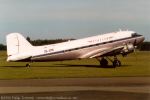
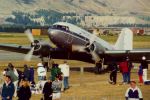
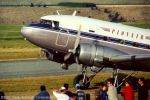
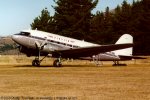
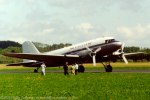
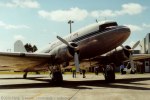
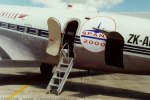
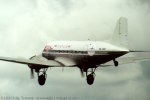
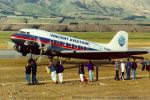
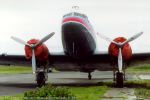
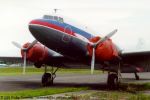
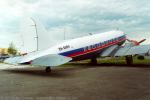
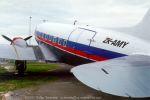
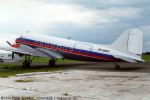
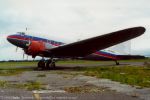
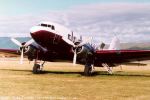
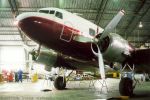

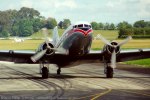
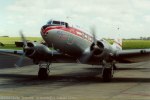
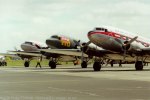
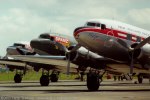

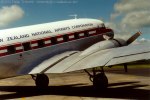
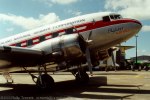
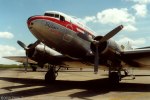
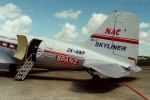
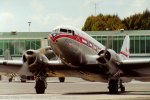
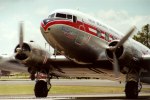
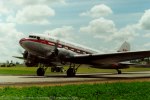
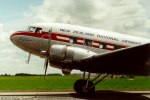
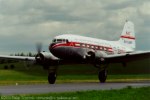
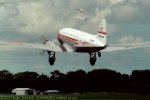
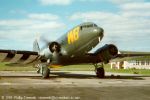
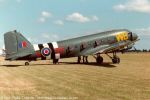
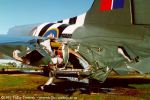
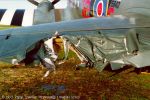
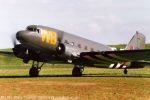
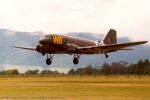
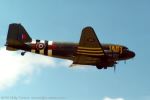
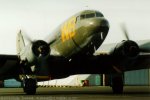
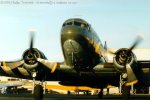
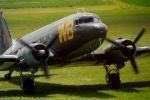
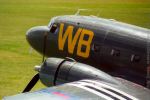
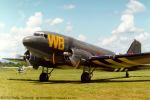
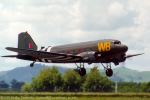
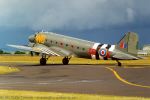
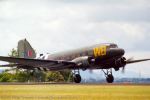
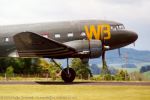
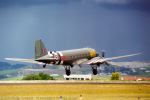
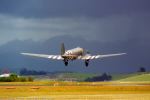
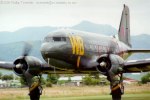
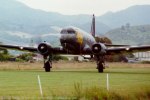
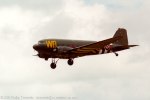
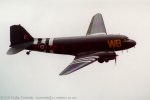
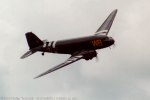
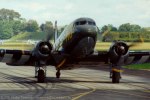
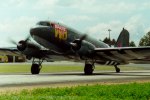
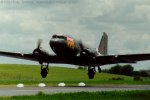
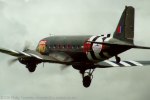
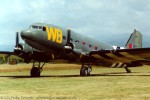
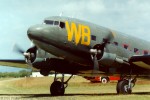
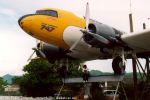

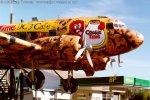
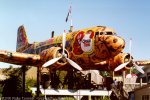
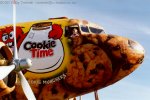
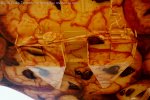
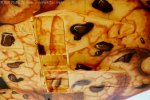
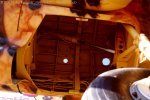

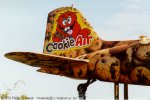
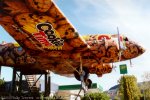
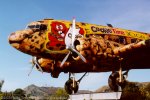
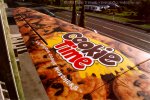
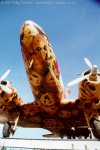
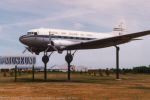
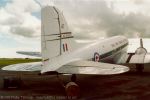
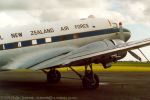
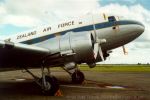
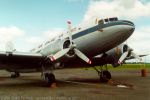
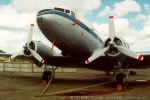
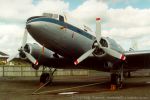
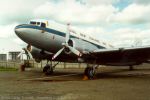
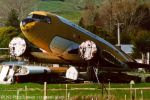
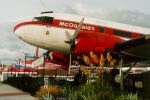
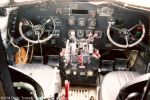
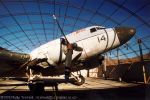
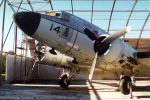
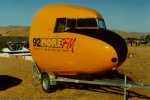
Close Up
Remember to let me know if you have a request for an image of a particular part of the aircraft!
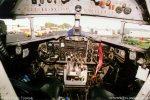
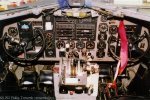
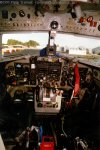
 © 1997-2003 Phillip Treweek, all rights reserved
© 1997-2003 Phillip Treweek, all rights reserved